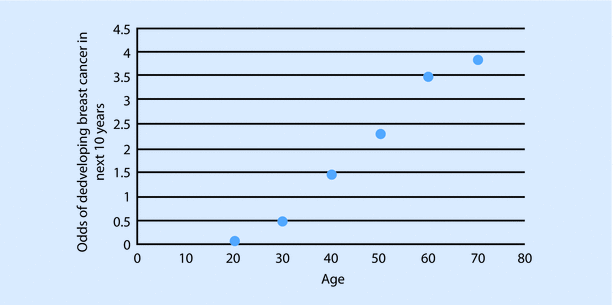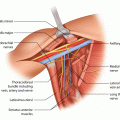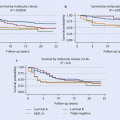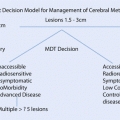Fig. 3.1
Number of new cases and deaths per 100,00 women in the USA (Source: National Cancer Institute [7])
Data from the Global Burden of Cancer Study (GLOBOCAN) suggests that approximately 464,000 new cases of breast cancer were diagnosed in Europe in 2012. This accounts for 29% of all female cancers and 13% of all cancers in Europe [8] (◘ Fig. 3.2).
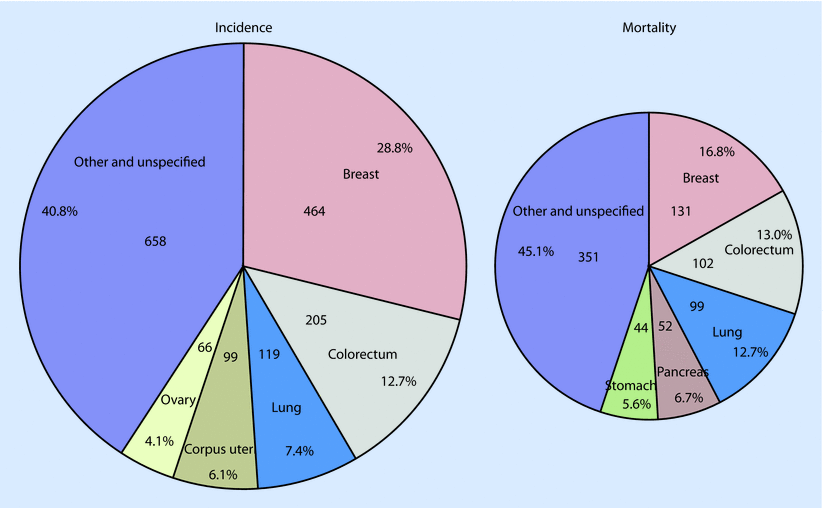

Fig. 3.2
Distribution of the expected cases and deaths for the five most common cancers in females in Europe 2012 (Reprinted from Ferlay et al. [9] with permission from Elsevier)
According to the European Cancer Observatory (EUCAN), incidence of breast cancer in Europe is 94.2 per 100,000 with rates as low as 63.4 per 100,000 in Central and Eastern Europe and as high as 126.8 per 100,000 in Western Europe [9].
Developing Countries
The incidence of breast cancer is lower in less economically developed parts of the world such as some Asian and African countries when compared to Western nations, with an estimated overall incidence for Africa at 28.0 per 100,000 women and 29.6 per 100,000 women for Asia [11].
3.2.3 Variation Within Continents
It is apparent that in both the developed and developing world, there is much variation between different regions and even countries within a continent. To give an example, in Europe the incidence of breast cancer in Bosnia is reported at 49.1 per 100,000, compared to 142.8 per 100,000 in Denmark [10]. It is hypothesised variation may be due to better registration of data in these countries, high socio-economic status and better access to healthcare (including screening) [12].
3.2.4 Incidence Patterns Over Time
In the USA, breast cancer incidence rates began decreasing at the beginning of the twenty-first century, dropping by 7% from 2002 to 2003 alone. One theory was the reduced use of hormone replacement therapy [13]. Contrary to the situation in the USA, breast cancer incidence rates in Europe have increased since the late 1970s, by 50% between 1979–1981 and 1998–2000 and then by 10% between 1998–2000 and 2011–2013 [14]. A similar pattern is seen in Japan with the incidence of breast cancer rising more than twofold from 1959–1960 to 1983–1987 [15–18]. We can speculate that this is due to a number of factors including an increased life expectancy of the general population and changes in lifestyle factors (e.g. obesity).
3.2.5 Immigration
Studies on migrants globally have demonstrated that, although initially the incidence of breast cancer of the country of origin is retained, within two or three generations, the incidence of the new country is ultimately adopted [19–21]. This suggests that some environmental factors have an impact on the overall incidence of breast cancer, which we will explore later in this chapter. Another theory would be that women moving to more economically developed countries have better access to healthcare facilities such as screening and, therefore, appear to have a higher incidence.
3.3 Risk Factors Associated with Breast Cancer
As previously eluded to, there are multiple potential risk factors which may contribute to the risk of breast cancer. The importance of these risk factors is measured by determining the relative risk (RR), defined as the ratio of the breast cancer probability occurring in the exposed group to the probability in a comparable but nonexposed group. These are grouped below into those with a relative risk of less than 4 and those with a RR of greater than 4.
◘ Table 3.1 provides a summary of these risk factors.
Table 3.1
Summary of breast cancer risk factors
Relative risk ≥4 | Relative risk <4 |
|---|---|
Female gender | Other family history |
Increasing age | Personal history of benign breast disease |
Past history of breast cancer | Significant family history |
Past history of other high-risk pathology | Younger age at menarche |
Previous radiation therapy | Older age at menopause |
Older age at first pregnancy | |
Use of hormone replacement therapy | |
Use of oral contraceptives | |
Lack of physical activity | |
Diet lacking in vegetable | |
Increased alcohol intake | |
Smoking |
3.3.1 Relative Risk Greater Than or Equal to 4 (RR ≥ 4)
Female Gender
The risk of females developing breast cancer is approximately 100 times greater than for males [22].
Age
The most important risk factor in the development of breast cancer after female gender is increasing age. It is estimated that there is a 1 in 1732 probability of developing breast cancer in the next 10 years for a woman with a current age of 20. This rises to 1 in 69 for individuals aged 40 and 1 in 26 for individuals aged 70 years [23] (◘ Fig. 3.3).
If all women younger than 65 years of age are compared with women aged over 65, the relative risk of breast cancer between both groups is 5.8 [24].
Genetic Mutations
The most well-known genes for increased susceptibility to breast cancer are BRCA1 and BRCA2 although the number of other significant genes is increasing as global genetic consortia analyse more genomes (reviewed in ► Chap. 6). The risk of developing breast cancer by age 70, if either BRCA1 or BRCA2 genes are present, is between 46% and 65%. The relative risk of breast cancer for carriers of BRCA mutations has been quoted to be as high as more than 200 below age 40 and 15 for ages 60–69 years [25].
For more information, please see ► Chap. 6.
Although the majority of cases of known genetic mutations are found in women with a significant family history, this is not always the case. For example, it is well recognised that younger patients with triple-negative breast cancer are highly likely to harbour a genetic mutation such as BRCA1 [26]; around 10–30% of women under the age of 60 diagnosed with «triple-negative» breast cancer will have a genetic mutation. Some specific national variation in rates of gene carriage accounts for higher than average breast cancer rates in certain populations (so-called founder mutations). The best known of these is in the Ashkenazi Jewish population, but founder mutations are also described elsewhere such as in Iceland and Spain.
Past History of Breast Cancer
Women who have had previous breast cancer are at two to five times increased risk of developing a second primary breast cancer [27].
Past History of High-Risk Pathology
Radiation Therapy
Women who have been previously treated with radiation therapy, for example, for lymphoma, leukaemia or bone tumours in childhood, are at greater risk of developing breast cancer. It is shown that treatments with moderate- to high-dose therapeutic chest radiation (≥20 Gy) have an elevated risk of breast cancer, and this does not plateau with increasing age [31].
As a result, enhanced screening or surveillance with MRI or mammography (depending on age) is offered to these women in some countries, for example, in Canada [32], and risk-reducing mastectomy is even discussed in some countries.
3.3.2 Relative Risk of Less Than 4 (RR < 4)
Family History
Although there is clearly a genetic relationship involving the incidence of breast cancer, it is estimated that only approximately 3–10% of breast cancers are inherited [22–24]. Having a positive family history of breast cancer, without a known genetic mutation, does increase the risk of breast cancer, with a relative risk of 1.5–2 [24]. For all women, having a first-degree female relative with breast cancer approximately doubles the risk of breast cancer, with risk increasing with younger age of the relative’s diagnosis [36]. Cancer Research UK suggests that the risk of developing breast cancer for an identical twin, where the first twin has already developed breast cancer, is 1 in 3, compared to overall lifetime risk of approximately 1 in 8 [27]. Risk increases with number of relatives affected, age at diagnosis, occurrence of bilateral or multiple ipsilateral tumours and male breast cancers in the family. However, it is difficult to tell if the underlying influence is genetic or environmental.
History of Benign Breast Disease
Research has shown that non-proliferative breast lesions such as breast cysts, duct ectasia or fat necrosis are not linked with an increased risk of developing breast cancer at a later date. Proliferative lesions without atypical cells, such as fibroadenomas or multiple intraductal papillomas, increase the risk of breast cancer development by up to two times [37].
Reproductive Factors
These elements can be largely grouped into those which cause greater or lesser lifetime exposure to sex hormones. It is hypothesised that greater exposure to oestrogens and androgens increases the likelihood of breast cancer.
Due to a longer duration of regular menstrual cycles and therefore longer lifetime exposure to the above-mentioned hormones, younger age at menarche and older age at menopause are associated with increased risk of hormone receptor (HR)-positive breast cancer [38]. This was shown in a study by the Collaborative Group on Hormonal Factors in Breast Cancer [39] where they examined data from 117 epidemiological studies encompassing 118,964 women with invasive breast cancer compared to 306,091 women without. They concluded that the risk of breast cancer increased by a factor of 1.050 for every year younger at menarche and by a factor of 1.029 for every year older at menopause.
An inverse association between parity and HR-positive breast cancer has been shown. An increasing number of pregnancies have been shown to decrease the risk of breast cancer [40, 41]. Risk estimates ranged from 0.5 to 0.8 [42]. However, women who give birth to their first child after age 30 have a higher risk for breast cancer than nulliparous women. It is speculated that a full-term pregnancy at an early age may reduce the likelihood of tumour initiation by causing further maturation of breast epithelial cells, while a full-term pregnancy at a later age may promote the growth of existing tumour cells The reduction in breast cancer risk associated with an increasing number of pregnancies was more consistently seen for oestrogen receptor (ER)-positive breast cancer [43, 44]. Increased age at first birth led to increased risk of breast cancer with the relative risk estimated to range from 1.4 to 2.6.
3.3.3 Exogenous Hormones
Hormone Replacement Therapy
Concurrent use of hormone replacement therapy (HRT) is significantly associated with an increased risk of HR-positive breast cancer. Two large observational studies published in 2002 and 2003 showed that current use of HRT was associated with an increased incidence and mortality from breast cancer. The effect was greater in oestrogen-progestin combinations, compared to other combinations of HRT [47, 48]. Following the publication of these two studies, the use of HRT in the USA dropped by 38% between 2002 and 2003, leading to a drop in breast cancer incidence of 7% [13].
Oral Contraceptives
A meta-analysis comparing oral contraceptive users versus non-users found a non-significant increase in breast cancer risk associated with ever use of oral contraceptives (RR 1.08 95% CI 0.99–1.17). Dose-response analysis showed that every 10 years use of the oral contraceptive was associated with a 14% increase in breast cancer risk [49].
A recent systematic review examined progesterone-only formulations of contraceptives and effect on breast cancer incidence and reported no association between progesterone-only formulations and breast cancer risk [50].
3.3.4 Physical Activity
Increased physical activity may reduce the risk of breast cancer. Studies have suggested that physical activity results in a lower ratio of oestrogen metabolites which have been shown to be associated with a decreased risk of breast cancer [51, 52].
A literature review identified that the highest level of physical activity (at least 150 min of vigorous physical activity per week) was associated with a relative risk of 0.88 for all breast cancers compared to the lowest level of physical activity [53]. Another literature review found that a lack of physical activity increased the risk of breast cancer. Moderate recreational physical activity, defined as about 3–4 hours of walking per week, may reduce breast cancer incidence [54].
3.3.5 Diet
Robust evidence for the role of diet in the risk of developing breast cancer is scarce. A primary prevention trial found that among postmenopausal women, a low-fat diet did not result in a statistically significant reduction in breast cancer risk over an average follow-up of 8 years. However, there were non-significant trends suggesting a reduced risk, and, therefore, the authors concluded that follow-up over a longer period of time may provide significant results [55]. A retrospective study using data from a cohort of 91,779 women found that greater consumption of a plant-based diet was associated with a reduced risk (RR 0.85) of breast cancer, particularly in HR-positive tumours [56].
3.3.6 Obesity
High BMI is associated with a higher risk of breast cancer in the postmenopausal population [57, 58]. In addition, longer duration of obesity has been shown to be associated with an increased risk of breast cancer in older adults [59]. Another study showed that this increased risk was associated with increased exposure to sex hormones, specifically oestrogens.
Women aged 55 years and older with a BMI in the 80th centile have a relative risk of 1.2 for developing breast cancer, compared to patients within the 20th centile [58, 60] (◘ Fig. 3.4).
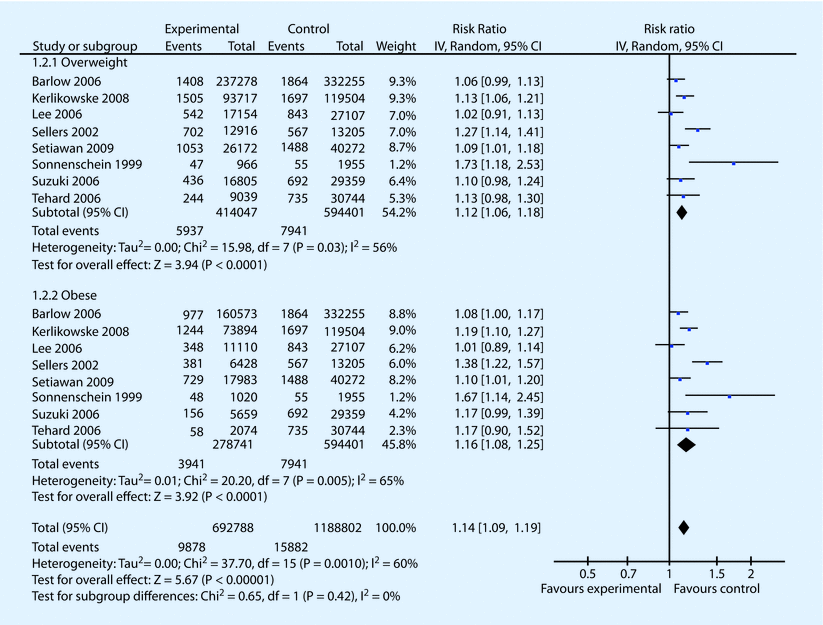

Fig. 3.4
Forest plot of odds ratio estimates of breast cancer in postmenopausal period by obesity (Reprinted from Cheraghi et al. [60]. Originally published under an Open Access CC BY license)
3.3.7 Alcohol
A pooled analysis of 53 studies including more than 58,000 women with breast cancer showed that daily consumption of about 50 g is associated with a relative risk of 1.5 (95% CI 1.3–1.6) compared with women who reported drinking no alcohol [63].
3.3.8 Smoking
Allen and colleagues found that the impact of smoking on breast cancer was confounded by alcohol use. When restricting the analysis to subjects who reported no alcohol intake, smoking was not associated with breast cancer [64].
3.3.9 Summary
This section of the chapter has presented a number of potential risk factors which may impact on the incidence of breast cancer. Overall, it is recognised that most of these factors relate to exposure to oestrogen. In addition, there are other factors such as genetic mutations and radiation exposure which are associated with an increased risk for breast cancer but which are not related to oestrogen exposure.
In the next section of this chapter, we will discuss how we can use knowledge of these aforementioned risk factors to aid in the prevention of breast cancer.
3.4 Prevention
Due to the complex aetiology of breast cancer, often an interaction between genetic and lifestyle factors, prevention may be equally complex and challenging.
There are clear guidelines and well-researched prevention/intervention strategies currently in use for women with an increased risk of breast cancer, including prophylactic surgery, chemoprevention and extra screening. These are discussed at length in other chapters of this book. Please refer to ► Chaps. 7 and 9, for further information.
Stay updated, free articles. Join our Telegram channel

Full access? Get Clinical Tree


